Alcatel 800A, OT-800A Instruction Manual
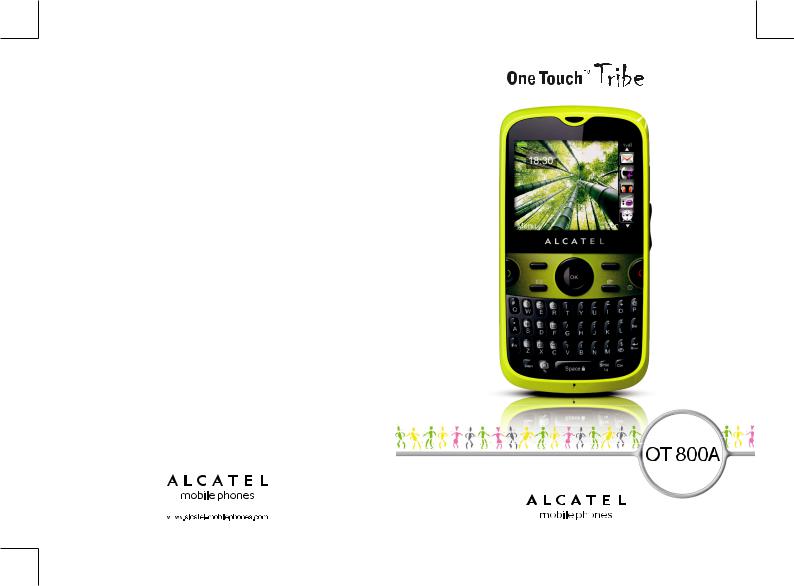
1 |
|
2 |
|
|
|
||
|
|
IP2608_800A_UM_ENG_USA_01_1005101-2 1-2 |
2010-5-10 13:55:53 |
|
|
|
|

Introduction................................
TCT Mobile Limited would like to thank you for purchasing this cellphone.
G-Sensor
- Fitness application
Used primarily by sports and physical fitness enthusiasts as an everyday exercise motivator, including pedometer, stopwatch and exercise program planner.
- Motion sensor
Easily skip to the previous/next song, channel or image, snooze an alarm or mute an incoming call.
Power media applications
-Music player & Radio
-Video & Streaming
-Webcam
The 2.0 Megapixel camera is the best companion for PC instant messaging.
Bluetooth
With Bluetooth 2.0 supporting A2DP profiles, enjoy handsfree conversations.
My friends
Popular websites (like bebo, Friendster, hi5, facebook, myspace, etc.) to stay in touch with your friends wherever you are, whenever you want.
1
Table of contents........................
Safety and use...................................................................... |
6 |
||
General information ......................................................... |
11 |
||
1 |
Your One Touch Tribe.................................................. |
13 |
|
|
1.1 |
Keys....................................................................................................... |
14 |
|
1.2 |
Main screen icons.............................................................................. |
16 |
2 |
Getting started............................................................ |
18 |
|
|
2.1 |
Set-up ................................................................................................... |
18 |
|
2.2 |
Power on your phone ...................................................................... |
20 |
|
2.3 |
Power off your phone ...................................................................... |
20 |
3 |
Calls .............................................................................. |
21 |
|
|
3.1 |
Making a call........................................................................................ |
21 |
|
3.2 |
Calling your voicemail ...................................................................... |
21 |
|
3.3 |
Receiving a call ................................................................................... |
22 |
|
3.4 |
During the call.................................................................................... |
23 |
|
3.5 |
Conference calls ................................................................................ |
24 |
|
3.6 |
Line switching..................................................................................... |
24 |
4 |
Menu arrange............................................................... |
25 |
|
5 |
Messages....................................................................... |
26 |
|
|
5.1 |
Messages:Text/Multimedia message ............................................. |
26 |
|
5.2 |
Email ..................................................................................................... |
29 |
|
5.3 |
Voice message .................................................................................... |
31 |
|
5.4 |
Photo message ................................................................................... |
31 |
|
5.5 |
Video message.................................................................................... |
31 |
|
5.6 |
Voicemail.............................................................................................. |
31 |
|
5.7 |
CB SMS ................................................................................................ |
31 |
|
5.8 |
WAP alerts.......................................................................................... |
31 |
|
5.9 |
Settings................................................................................................. |
31 |
|
|
2 |
|
IP2608_800A_UM_ENG_USA_01_1005101-2 1-2 |
2010-5-10 13:55:54 |
|
|
|
|

6 Instant messaging........................................................ |
33 |
|
6.1 |
Access .................................................................................................. |
33 |
6.2 |
Open a Palringo account online .................................................... |
33 |
6.3 |
Sign in/Sign out................................................................................... |
33 |
6.4 |
Add service......................................................................................... |
34 |
6.5 |
Chat ...................................................................................................... |
34 |
6.6 |
Contacts .............................................................................................. |
34 |
6.7 |
Groups ................................................................................................. |
34 |
7 Directory...................................................................... |
35 |
|
7.1 |
Accessing your phonebook/directory .......................................... |
35 |
7.2 |
Creating a file ..................................................................................... |
36 |
7.3 |
Available options................................................................................ |
37 |
8 Call register ................................................................. |
39 |
|
8.1 |
Call memory....................................................................................... |
39 |
8.2 |
My numbers ........................................................................................ |
39 |
8.3 |
Billing .................................................................................................... |
39 |
8.4 |
Call settings......................................................................................... |
40 |
9 Media applications....................................................... |
42 |
|
9.1 |
Music player ........................................................................................ |
42 |
9.2 |
Image Viewer....................................................................................... |
43 |
9.3 |
Video player........................................................................................ |
44 |
9.4 |
Radio..................................................................................................... |
44 |
10 Internet ........................................................................ |
46 |
|
10.1 |
My friends............................................................................................ |
46 |
10.2 |
Opera ................................................................................................... |
46 |
10.3 |
Web ...................................................................................................... |
46 |
10.4 |
News .................................................................................................... |
47 |
10.5 |
Weather............................................................................................... |
48 |
11 Entertainment |
............................................................. 49 |
|
11.1 |
Fun ........................................................................................................ |
49 |
11.2 |
Ebook ................................................................................................... |
50 |
11.3 |
Java ........................................................................................................ |
50 |
|
|
3 |
12 Camera......................................................................... |
52 |
|
12.1 |
Access .................................................................................................. |
52 |
12.2 |
Camera ................................................................................................ |
52 |
12.3 |
Video .................................................................................................... |
54 |
13 Profiles.......................................................................... |
57 |
|
13.1 |
General ................................................................................................ |
57 |
13.2 |
Meeting ................................................................................................ |
58 |
13.3 |
Outdoor .............................................................................................. |
58 |
13.4 |
Indoor................................................................................................... |
58 |
13.5 |
Silence .................................................................................................. |
58 |
13.6 |
Antenna off mode ............................................................................. |
58 |
14 File manager ................................................................ |
59 |
|
14.1 |
My audio .............................................................................................. |
59 |
14.2 |
My images............................................................................................ |
59 |
14.3 |
My videos ............................................................................................ |
59 |
14.4 |
My creations ....................................................................................... |
60 |
14.5 |
Unknown files..................................................................................... |
60 |
14.6 |
Ebook ................................................................................................... |
60 |
14.7 |
Phone.................................................................................................... |
60 |
14.8 |
Memory card...................................................................................... |
60 |
14.9 |
Managing audios, images, videos and creations........................... |
61 |
14.10 |
Formats and compatibility............................................................... |
62 |
14.11 |
Memory status ................................................................................... |
62 |
15 Bluetooth ..................................................................... |
63 |
|
16 Other ............................................................................ |
65 |
|
16.1 |
Calendar .............................................................................................. |
65 |
16.2 |
Calculator............................................................................................ |
65 |
16.3 |
Notes.................................................................................................... |
66 |
16.4 |
Tasks ..................................................................................................... |
66 |
16.5 |
Clock .................................................................................................... |
67 |
16.6 |
Converter ......................................................................................... |
67 |
|
4 |
|
IP2608_800A_UM_ENG_USA_01_1005103-4 3-4 |
2010-5-10 13:55:55 |
|
|
|
|

17 Settings......................................................................... |
68 |
|
17.1 |
Display.................................................................................................. |
68 |
17.2 |
Languages ........................................................................................... |
70 |
17.3 |
Headset mode.................................................................................... |
70 |
17.4 |
Input mode.......................................................................................... |
70 |
17.5 |
Vocabulary........................................................................................... |
70 |
17.6 |
Motion sensor.................................................................................... |
70 |
17.7 |
Keypad.................................................................................................. |
71 |
17.8 |
Security ................................................................................................ |
72 |
17.9 |
Network .............................................................................................. |
73 |
17.10 |
Connectivity........................................................................................ |
73 |
18 |
Making the most of your cellphone........................... |
74 |
|
18.1 PC suite ............................................................................................... |
74 |
19 |
Latin input mode/character table ............................. |
75 |
20 |
Telephone warranty .................................................... |
78 |
21 |
Accessories................................................................... |
80 |
22 |
Troubleshooting .......................................................... |
81 |
5
Safety and use.............................
We recommend that you read this chapter carefully before using your cellphone.The manufacturer disclaims any liability for damage, which may result as a consequence of improper use or use contrary to the instructions contained herein.
• TRAFFIC SAFETY:
Given that studies show that using a cellphone while driving a vehicle constitutes a real risk, even when the hands-free kit is used (car kit, headset...), drivers are requested to refrain from using their cellphone when the vehicle is not parked. Check the laws and regulations on the use of wireless telephones and their accessories in the areas where you drive.Always obey them.The use of these devices may be prohibited or restricted in certain areas.
When driving, do not use your cellphone and headphone to listen to music or to the radio. Using a headphone can be dangerous and forbidden in some areas.
When switched on, your cellphone emits electromagnetic waves that can interfere with the vehicle’s electronic systems such as ABS anti-lock brakes or airbags.To ensure that there is no problem:
-do not place your cellphone on top of the dashboard or within an airbag deployment area,
-check with your car dealer or the car manufacturer to make sure that the car’s electronic devices are shielded from cellphone RF energy.
• CONDITIONS OF USE:
You are advised to switch off the cellphone from time to time to optimize its performance. Switch the cellphone off before boarding an aircraft to avoid prosecution.
Switch the cellphone off when you are in health care facilities, except in designated areas. As with many other types of equipment now in regular use, cellphones can interfere with other electrical or electronic devices, or equipment using radio frequency.
Switch the cellphone off when you are near gas or flammable liquids. Strictly obey all signs and instructions posted in a fuel depot, gas station, or chemical plant, or in any potentially explosive atmosphere.
When the cellphone is switched on, it should be kept at least 15 cm from any medical device such as a pacemaker, a hearing aid or insulin pump. In particular when using the cellphone you should hold it against the ear on the opposite side to the device, if any.
To avoid hearing impairment, answer the call before holding your cellphone to your ear.Also move the handset away from your ear while using the “hands-free” option because the amplified volume might cause hearing damage.
Do not let small children use your cellphone without supervision.
When replacing the cover please note that your cellphone may contain substances that could create an allergic reaction.
Always handle your cellphone with care and keep it in a clean and dust-free place.
Do not allow your cellphone to be exposed to adverse weather or environmental conditions (moisture, humidity, rain, infiltration of liquids, dust, sea air, etc.).The manufacturer’s recommended operating temperature range is -10°C to +55°C (the max value depends on device, materials and housing paint/texture).
6
IP2608_800A_UM_ENG_USA_01_1005105-6 5-6 |
2010-5-10 13:55:56 |
|
|
|
|
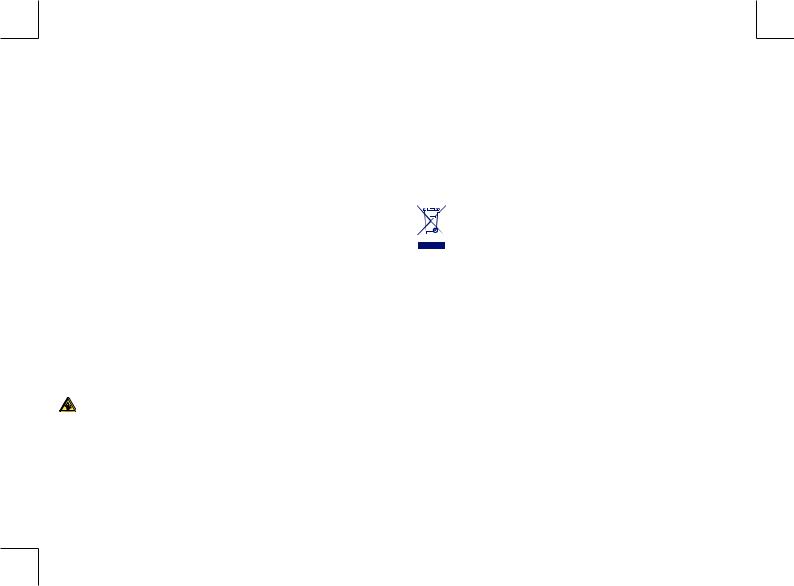
Over 55°C the legibility of the cellphone’s display may be impaired, though this is temporary and not serious.
Do not open or attempt to repair your cellphone yourself. Do not drop, throw or try to bend your cellphone.
Do not paint it.
Use only batteries, battery chargers, and accessories which are recommended by TCT Mobile Limited and its affiliates and are compatible with your cellphone model (see Accessories List, page 80). TCT Mobile Limited and its affiliates disclaim any liability for damage caused by the use of other chargers or batteries.
Your cellphone should not be disposed of in a municipal waste. Please check local regulations for disposal of electronic products.
Remember to make back-up copies or keep a written record of all important information stored in your cellphone.
Some people may suffer epileptic seizures or blackouts when exposed to flashing lights, or when playing video games.These seizures or blackouts may occur even if a person never had a previous seizure or blackout. If you have experienced seizures or blackouts, or if you have a family history of such occurrences, please consult your doctor before playing video games on your cellphone or enabling a flashing-lights feature on your cellphone. Parents should monitor their children’s use of video games or other features that incorporate flashing lights on the cellphones. All persons should discontinue use and consult a doctor if any of the following symptoms occur: convulsion, eye or muscle twitching, loss of awareness, involuntary movements, or disorientation. To limit the likelihood of such symptoms, please take the following safety precautions:
-Do not play or use a flashing-lights feature if you are tired or need sleep.
-Take a minimum of a 15-minute break hourly.
-Play in a well lit environment.
-Play at the farthest distance possible from the screen.
When you play games on your cellphone, you may experience occasional discomfort in your hands, arms, shoulders, neck, or other parts of your body. Follow these instructions to avoid problems such as tendinitis, carpal tunnel syndrome, or other musculoskeletal disorders:
-Take a minimum of a 15-minute break every hour of game playing.
-If your hands, wrists, or arms become tired or sore while playing, stop and rest for several hours before playing again.
-If you continue to have sore hands, wrists, or arms during or after playing, stop the game and see a doctor.
Prolonged exposure to music at full volume using the music player may damage your hearing. Set your phone’s volume to it’s lowest setting prior to inserting headphones in your ears and adjust the volume to your preference. Only use headphones that are recommended by TCT Mobile Limited and it’s affiliates.
• PRIVACY:
Please note that you must respect the laws and regulations in force in your jurisdiction or other jurisdiction(s) where you will use your cellphone regarding taking photographs and recording sounds with your cellphone. Pursuant to such laws and regulations, it may be strictly forbidden to take photographs and/or to record the voices of other people or any of their personal attributes, and reproduce or distribute them, as this may be considered to be an invasion of privacy.
7
It is the user’s sole responsibility to ensure that prior authorization be obtained, if necessary, in order to record private or confidential conversations or take a photograph of another person; the manufacturer, the seller or vendor of your cellphone (including the operator) disclaim any liability which may result from the improper use of the cellphone.
• BATTERY AND ACCESSORIES:
Before removing the battery from your cellphone, please make sure that the cellphone is switched off. Observe the following precautions for battery use:
- Do not attempt to open the battery (due to the risk of toxic fumes and burns). - Do not puncture, disassemble or cause a short-circuit in a battery,
-Do not burn or dispose of a used battery in the garbage or store it at temperatures above 60°C.
Batteries must be disposed of in accordance with locally applicable environmental regulations. Only use the battery for the purpose for which it was designed. Never use damaged batteries or those not recommended by TCT Mobile Limited and/or its affiliates.
This symbol on your telephone, the battery and the accessories means that these products must be taken to collection points at the end of their life:
- Municipal waste disposal centres with specific bins for these items of equipment
- Collection bins at points of sale.
They will then be recycled, preventing substances being disposed of in the environment, so that their components can be reused.
In European Union countries:
These collection points are accessible free of charge. All products with this sign must be brought to these collection points.
In non European Union jurisdictions:
Items of equipment with this symbol are not be thrown into ordinary bins if your jurisdiction or your region has suitable recycling and collection facilities; instead they are to be taken to collection points for them to be recycled.
In the United States you may learn more about CTIA’s Recycling Program at www.recyclewirelessphones.com
CAUTION: RISK OF EXPLOSION IF BATTERY IS REPLACED BY AN INCORRECT TYPE. DISPOSE OF USED BATTERIES ACCORDING TO THE INSTRUCTIONS.
• CHARGERS
Home A.C./ Travel chargers will operate within the temperature range of: 0°C to 40°C.
The chargers designed for your cellphone meet with the standard for safety of information technology equipment and office equipment use. Due to different applicable electrical specifications, a charger you purchased in one jurisdiction may not work in another jurisdiction.They should be used for this purpose only.
Characteristics of power supply (depending on the country): Travel charger: Input: 00-240 V, 50/60 Hz, 0.15 A
|
Output: 5 V, 500 mA |
Battery: |
Lithium 850 mAh. |
8
IP2608_800A_UM_ENG_USA_01_1005107-8 7-8 |
2010-5-10 13:55:56 |
|
|
|
|
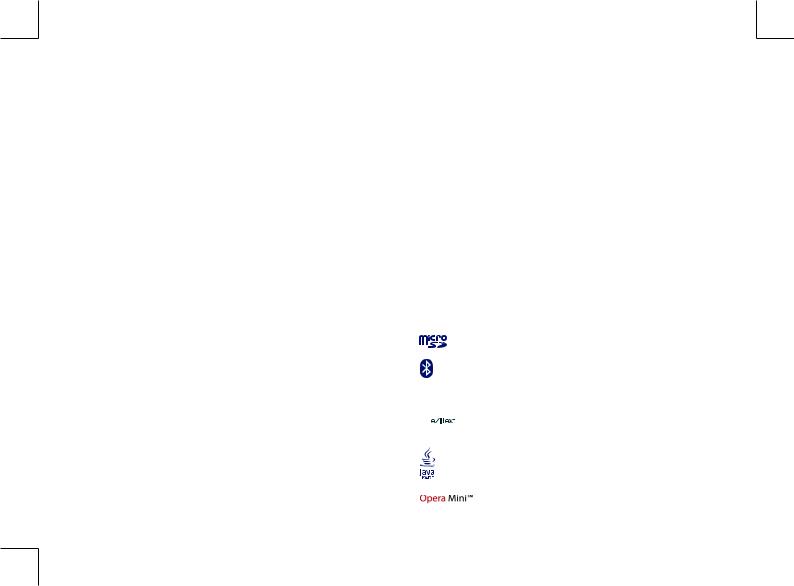
• RADIO WAVES:
THIS CELLPHONE MEETS THE GOVERNMENT’S REQUIREMENTS FOR EXPOSURE TO RADIO WAVES.
Your cellphone is a radio transmitter and receiver. It is designed and manufactured not to exceed the emission limits for exposure to radio-frequency (RF) energy. These limits are part of comprehensive guidelines and establish permitted levels of RF energy for the general population. The guidelines are based on standards that were developed by independent scientific organizations through periodic and thorough evaluation of scientific studies.These guidelines include a substantial safety margin designed to ensure the safety of all persons, regardless of age and health.
The exposure standard for cellphones employs a unit of measurement known as the Specific Absorption Rate, or SAR. The SAR limit set by public authorities such as the Federal Communications Commission of the US Government (FCC), or by Industry Canada, is 1.6 W/kg averaged over gram of body tissue.Tests for SAR are conducted using standard operating positions with the cellphone transmitting at its highest certified power level in all tested frequency bands.
Although the SAR is determined at the highest certified power level, the actual SAR level of the cellphone while operating can be well below the maximum value.This is because the cellphone is designed to operate at multiple power levels so as to use only the power required to reach the network. In general, the closer you are to a wireless base station antenna, the lower the power output of the cellphone Before a cellphone model is available for sale to the public, compliance with national regulations and standards must be shown.
The highest SAR value for this model cellphone when tested is 1.17 W/Kg for use at the ear and 1.26 W/Kg for use close to the body.
While there may be differences between the SAR levels of various cellphones and at various positions, they all meet the government requirement for RF exposure. For body-worn operation, the cellphone meets FCC RF exposure guidelines provided that it is used with a non-metallic accessory with the handset at least 1.5 cm from the body. Use of other accessories may not ensure compliance with FCC RF exposure guidelines.
The World Health Organization (WHO) considers that present scientific information does not indicate the need for any special precautions for use of cellphones. If individuals are concerned, they might choose to limit their own or their children’s RF exposure by limiting the length of calls, or using “hands-free” devices to keep cellphones away from the head and body. (fact sheet n°193). Additional WHO information about electromagnetic fields and public health are available on the following website: http://www.who.int/peh-emf.
Note: This equipment has been tested and found to comply with the limits for a Class B digital device pursuant to part 15 of the FCC Rules. These limits are designed to provide reasonable protection against harmful interference in a residential installation. This equipment generates, uses and can radiate radio frequency energy and, if not installed and used in accordance with the instructions, may cause harmful interference to radio communications. However, there is no guarantee that interference to radio or television reception, which can be determined by turning the equipment off and on, the user is encouraged to try to correct the interference by one or more of the following measures:
9
-Reorient or relocate the receiving antenna.
-Increase the separation between the equipment and receiver.
-Connect the equipment into an outlet on a circuit different from that to which the receiver is connected.
-Consult the dealer or an experienced radio/ TV technician for help.
Changes or modifications not expressly approved by the party responsible for compliance could void the user’s authority to operate the equipment.
For the receiver devices associated with the operation of a licensed radio service (e.g. FM broadcast), they bear the following statement:
This device complies with Part 15 of the FCC Rules. Operation is subject to the condition that this device does not cause harmful interference.
For other devices, they bear the following statement:
This device complies with Part 15 of the FCC Rules. Operation is subject to the following two conditions:
(1)this device may not cause harmful interference
(2)this device must accept any interference received, including interference that may cause undesired operation.
Your cellphone is equipped with a built-in antenna. For optimal operation, you should avoid touching it or degrading it.
As mobile devices offer a range of functions, they can be used in positions other than against your ear. In such circumstances the device will be compliant with the guidelines when used with headset or usb data cable. If you are using another accessory ensure that whatever product is used is free of any metal and that it positions the phone at least 2cm away from the body.
• LICENCES
Obigo® |
is a registered trademark of Obigo AB. |
||
|
|
|
microSD Logo is a trademark. |
|
|
|
The Bluetooth word mark and logos are owned by the Bluetooth SIG, Inc. and |
|
|
|
any use of such marks by TCT Mobile Limited and its affiliates is under license. |
|
|
|
Other trademarks and trade names are those of their respective owners. |
|
|
|
OT-800A Bluetooth QD ID B015352 |
|
|
|
eZiText™ and Zi™ are trademarks of Zi Corporation and/or its Affiliates. |
|
|
|
|
|
|
|
|
|
|
|
Java™ and all Java™ based trademarks and logos are trademarks or registered |
|
|
|
trademarks of Sun Microsystems, Inc. in the U.S. and other countries. |
|
|
|
is a registered trademark of Opera Mini. |
|
|
|
10 |
IP2608_800A_UM_ENG_USA_01_1005109-10 9-10 |
2010-5-10 13:55:57 |
|
|
|
|

General information ..................
•Internet address: www.alcatel-mobilephones.com
•Hot Line Number: In the United States, call 877-702-3444 for technical support.
On our Internet site, you will find our FAQ (Frequently Asked Questions) section. You can also contact us by e-mail to ask any questions you may have.
An electronic version of this user guide is available in English and other languages according to availability on our server: www.alcatelmobilephones.com
Your telephone is a transceiver that operates on GSM networks with 850, 1800 and 1900 MHz bands.
11
Protection against theft (1)
Your cellphone is identified by an IMEI (cellphone serial number) shown on the packaging label and in the product’s memory.We recommend that you note the number the first time you use your cellphone by entering *#06# and keep it in a safe place. It may be requested by the police or your operator if your cellphone is stolen.
Disclaimer
There may be certain differences between the user manual description and the cellphone’s operation, depending on the software release of your cellphone or specific operator services.
(1)Contact your network operator to check service availability.
12
IP2608_800A_UM_ENG_USA_01_10051011-12 11-12 |
2010-5-10 13:55:58 |
|
|
|
|
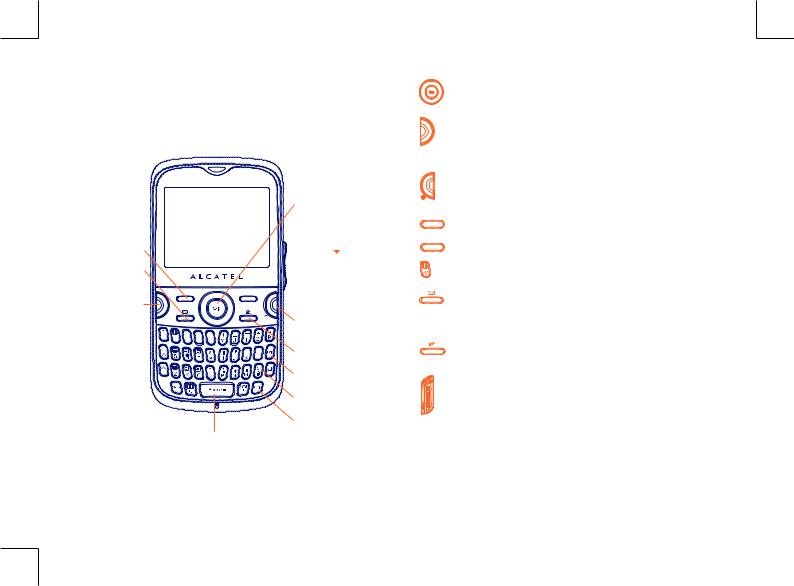
1 Your One Touch Tribe...........
Left softkey
Message key
Answer/Send call
Call memory
Voicemail 



Caps key 
Lock/Unlock
Navigation key (1): Main menu, confirm an option 
 Messages
Messages  (2) Directory
(2) Directory  (2) Alarm
(2) Alarm 
File manager  Volume
Volume 
 Side key
Side key
 Right softkey
Right softkey
Switch on/ Switch off End call
Camera key
Del key
Vibration alert
Ctrl key
(1)Depending on your network operator.
(2)Disabled when events (incoming call, SMS/MMS, news, weather, appointments etc.) displayed on main screen.
13
1.1Keys
Navigation key
Confirm an option (press the middle of the key)
Answer
Send a call
Access call memory (Redial) (short keypress)
Switch on/Switch off the telephone (long keypress)
End call
Return to the main screen
Left softkey
Right softkey
Access your voicemail (long keypress)
Create message (short keypress)
Create email (long keypress)
Send a message to a contact (in Directory)
Take photos (short keypress)
Record videos (long keypress)
Side key
-Push: Access “Music player”,“Radio”,“World clock”, “Image viewer”,“News”,“Weather”, etc. Confirm an option
-Scroll up/down: Volume up/down
Previous/next menu
14
IP2608_800A_UM_ENG_USA_01_10051013-14 13-14 |
2010-5-10 13:55:59 |
|
|
|
|
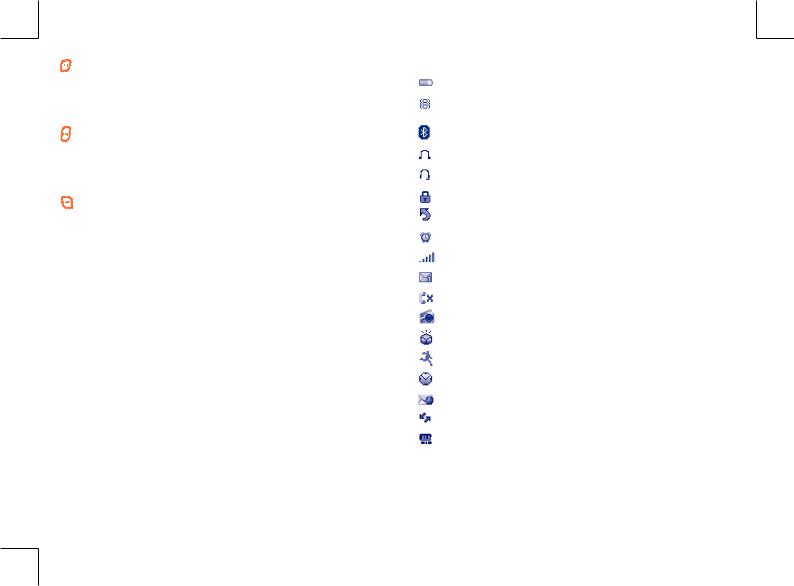
Ctrl + B: Activate/Deactivate Bluetooth
Ctrl + M: Access Music player
Ctrl + P: Access Profiles
Ctrl + J: Access Java applications
Delete a contact (in Directory/Call memory)
Delete a message (in Inbox/Outbox…)
Delete a file (in File manager)
Delete a note (in Notes)
Shift sound play among Headset, Bluetooth and Headset & Bluetooth (long keypress).
15
1.2Main screen icons (1)
Battery charge level
Vibrate alert is active and phone will not ring or beep with the exception of active alarms. (see page 57).
Bluetooth status (Blue - Activated).
Bluetooth status (Connected to an audio device).
Headset connected.
Keypad locked.
Call forwarding activated: your calls are forwarded (see page 40).
Alarm clock (see page 67).
Level of network reception.
New voicemail message(s).
Missed calls.
Radio is on.
Motion sensor is active.
Pedometer is running in background.
Stopwatch is active.
WAP alerts (2).
Roaming.
Memory card scanning in progress.
(1)The icons and illustrations in this guide are provided for informational purposes only.
(2)Depending on your network operator.
16
IP2608_800A_UM_ENG_USA_01_10051015-16 15-16 |
2010-5-10 13:56:00 |
|
|
|
|
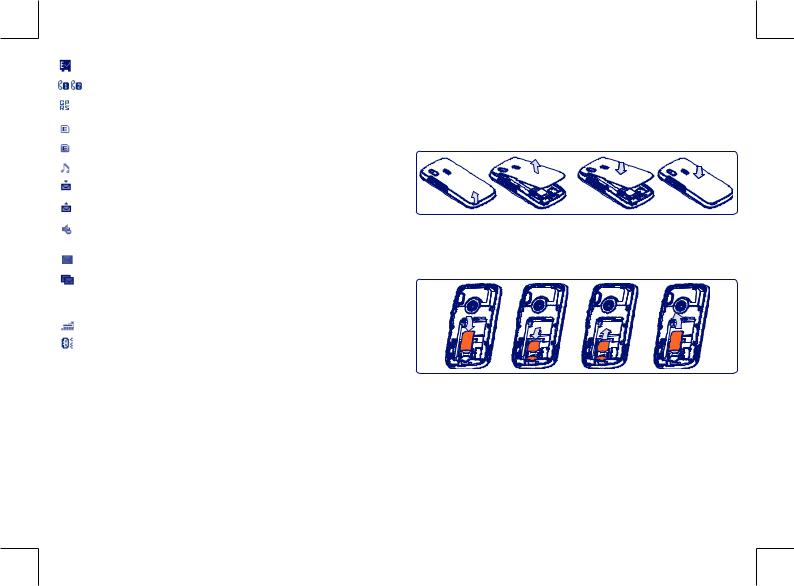
Memory card scanning completed.
Line switching (1): indicates the selected line.
GPRS connection status (Blue - Activated).
GPRS Active.
GPRS connecting.
Music player active.
Message receipt in progress.
Sending a message.
In silence mode, your phone will not ring, beep or vibrate with the exception of active alarms set.
Message unread
Message list is full: your phone cannot accept any new messages until one or more messages are deleted from your SIM card’s message list.
Antenna off mode.
A2DP connected.
2 Getting started .....................
2.1Set-up
Removing or installing the back cover
Inserting or removing the SIM card (1)
You must insert your SIM card to make phone calls.
(1)Contact your network operator to check service availability.
17
IP2608_800A_UM_ENG_USA_01_10051017-18 17-18
Place the SIM card with the bronze colored chip facing downwards and slide it into its housing. Make sure that it is correctly inserted.To remove the card, press the bottom and slide it out. Please power off your phone before you remove the SIM card.
(1)Check with your network operator to make sure that your SIM card is 3V or 1.8V compatible.The old 5 Volt cards can no longer be used. Please contact your operator.
18
2010-5-10 13:56:01
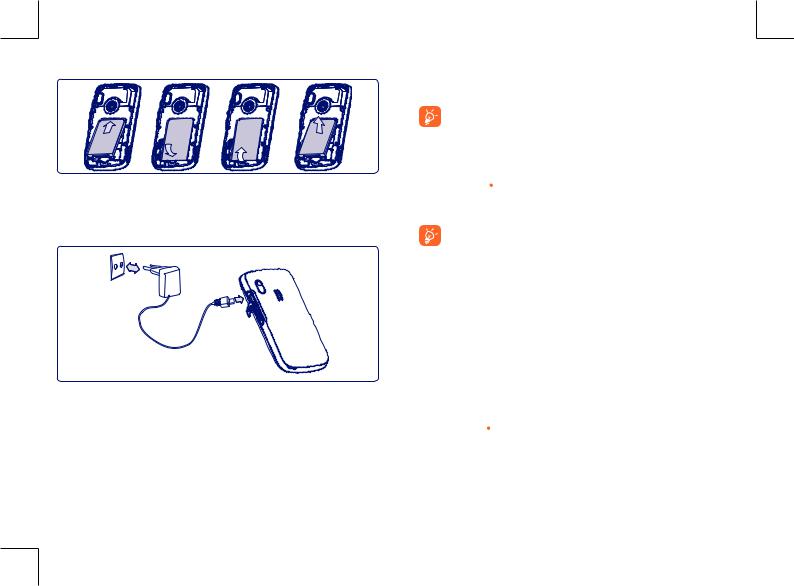
Installing or removing the battery
Insert and click the battery into place, then close the telephone cover. Unclip the cover, then remove the battery.
Charging the battery
Connect the battery charger
•Charging may take about 20 minutes to start if the battery is flat.
•Be careful not to force the plug into the socket.
•Make sure the battery is correctly inserted before connecting the charger.
•The mains socket must be near to the phone and easily accessible (avoid electric extension cables).
19
•When using your telephone for the first time, charge the battery fully (approximately 3 hours). You are advised to fully charge the battery (  ).
).
The charge is complete when the animation stops. Only use Alcatel chargers.
2.2Power on your phone
Hold down the  key until the telephone powers on, type in your PIN code if necessary and then confirm with the
key until the telephone powers on, type in your PIN code if necessary and then confirm with the 
 key.The main screen is displayed.
key.The main screen is displayed.
If you do not know your PIN code or if you have forgotten it, contact your network operator. Do not leave your PIN code with your telephone. Store this information in a safe place when not in use.
If cell broadcast messages are displayed, use the 
 key to browse through them or press the right softkey to return to the main screen.
key to browse through them or press the right softkey to return to the main screen.
While the phone is searching for a network, “Searching/Emergency” will be displayed.
In the power on screen, you also have access to the functions of “Radio”, “Camera”,“Music player”, etc. even if there is no SIM card inserted.
2.3Power off your phone
Hold down the  key from the main screen.
key from the main screen.
20
IP2608_800A_UM_ENG_USA_01_10051019-20 19-20 |
2010-5-10 13:56:03 |
|
|
|
|
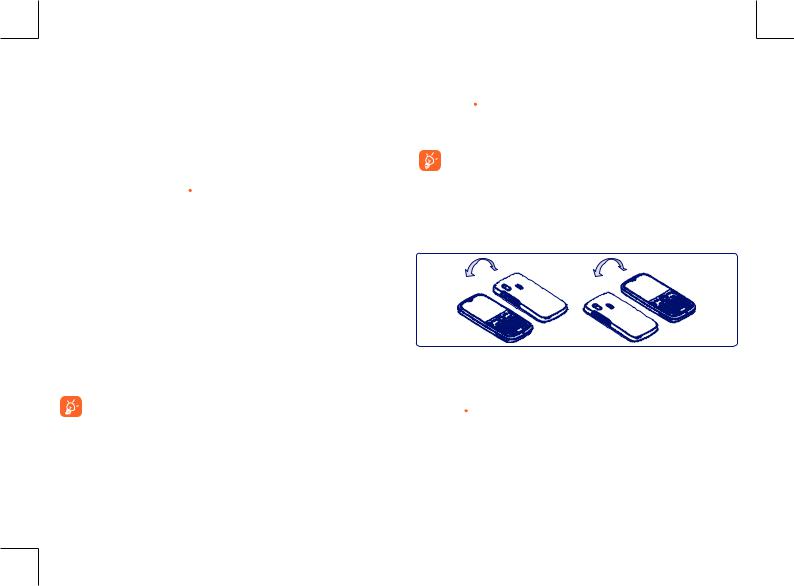
3 Calls.......................................
3.1Making a call
Dial the desired number then press the  key to place the call. If you make a mistake, you can delete the incorrect digits by pressing the right softkey or
key to place the call. If you make a mistake, you can delete the incorrect digits by pressing the right softkey or  key.
key.
To hang up the call, press the  key.
key.
Making an emergency call
If your phone has network coverage, dial emergency number and press the  key to make an emergency call.This works even without a SIM card and
key to make an emergency call.This works even without a SIM card and
without typing the PIN code or unlocking the keypad.
3.2Calling your voicemail (1)
Your voicemail is provided by your network to avoid missing calls. It works like an answering machine that you can consult at any time.To access your voicemail, hold down the  key.
key.
If the access number for your operator’s voicemail service does not work, dial the number that you were given.To change this number at a later date, refer to “My numbers” (see page 39).
To use your voicemail service from abroad, contact your network operator before leaving.
(1)Contact your network operator to check service availability.
21
3.3Receiving a call
When you receive an incoming call, press the  key to talk and then hang up using the
key to talk and then hang up using the  key.
key.
If the  icon is displayed, the vibrator is activated and there is no ringtone. If the
icon is displayed, the vibrator is activated and there is no ringtone. If the  icon is displayed, the phone neither rings nor vibrates.
icon is displayed, the phone neither rings nor vibrates.
The caller’s number is displayed if it is transmitted by the network (contact your network operator to check service availability).
Muting the ringtone
To mute ringtone of current incoming call, press the right softkey once, or flip your phone 180° when it is activated as “On” (see page 71). Answer the call by pressing the  key.
key.
Flip 180°
Rejecting a call
Press the  key once or the right softkey twice, or reject it by SMS (Options\Reject by SMS\Templates).
key once or the right softkey twice, or reject it by SMS (Options\Reject by SMS\Templates).
22
IP2608_800A_UM_ENG_USA_01_10051021-22 21-22 |
2010-5-10 13:56:03 |
|
|
|
|
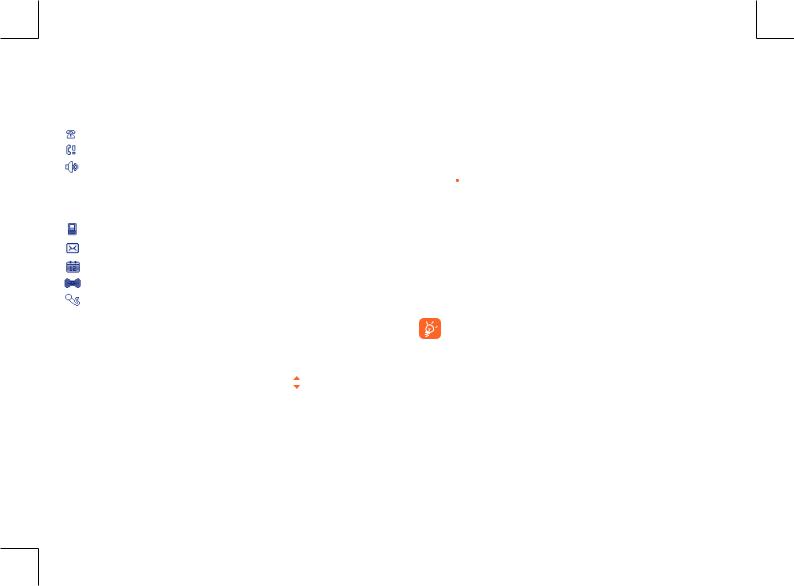
3.4During a call
Available functions
During a call, press the 
 key to use your directory, diary, short messages etc. without losing your caller.
key to use your directory, diary, short messages etc. without losing your caller.
Call on hold
Ongoing call
Handsfree
WARNING: move the handset away from your ear while using the “handsfree” option because the amplified volume might cause hearing damage.
Directory
Messages
Calendar
Services (1)
Sound recorder (record your current call).
You can switch the audio speech from handset to BT device when connected.
Adjusting the volume
You can adjust the sound level during a call using the |
key or Side key. |
Handling two calls
•Answering a second call (ensure that “Call waiting” is activated, see page 40).
•To call a second party during a call, dial the number directly.
(1)Contact your network operator to check service availability.
23
3.5Conference calls (1)
Your phone allows you to talk to several people at the same time (up to five). If you are on a double call, press “Options” and select “Conference” then confirm with the 
 key. If a third call comes in, answer it by pressing the
key. If a third call comes in, answer it by pressing the  key and speak with your new caller.
key and speak with your new caller.
This caller becomes a member of the conference if you press “Options” and select “Add to conference”, and then confirm by pressing 
 . Pressing
. Pressing  disconnects the current call.
disconnects the current call.
To end the conference call, press “Options” and select “End conference”.
3.6Line switching (1)
Your SIM card can contain two distinct telephone numbers. Under “Call register”, choose “Line switching” and then select a default line; all your outgoing calls will be made from this number. Incoming calls, however, will continue to use either of the two lines.
The services programmed on the default line do not impact those selected on the other line.
(1)Contact your network operator to check service availability.
24
IP2608_800A_UM_ENG_USA_01_10051023-24 23-24 |
2010-5-10 13:56:05 |
|
|
|
|
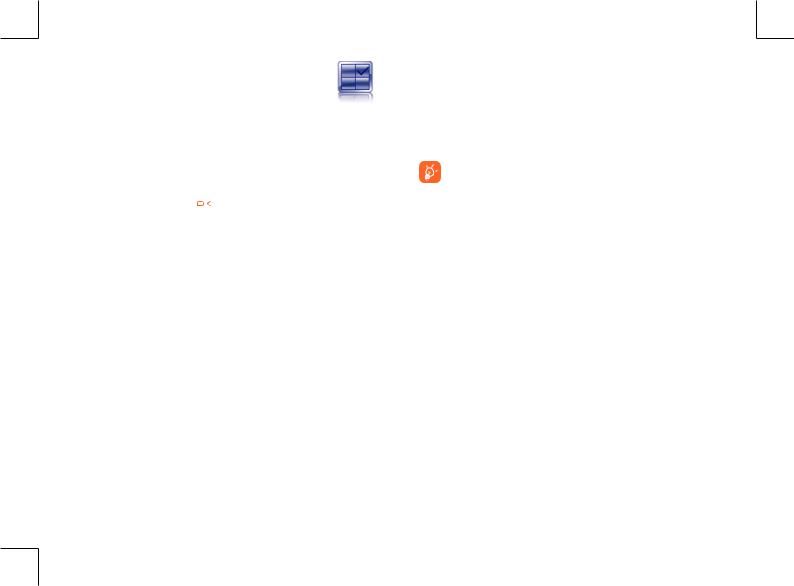
4 Menu arrange........................
Items in the main menu may be arranged to your preference.
Changing order of menu items
Press left softkey and select “Move” or long keypress Side key/
 key until tick “√” is shown, then move the cursor to your favorite destination and confirm with
key until tick “√” is shown, then move the cursor to your favorite destination and confirm with 
 key.
key.
Show/Hide |
|
|
Select “Menu arrange”, press |
|
to show/hide the main menu. |
|
||
|
||
• Messages |
|
• File manager |
• Instant messaging |
|
• Calculator |
• Web |
|
• Notes |
• Opera |
|
• Tasks |
• Directory |
|
• Ebook |
• Calendar |
|
• Clock |
• Radio |
|
• Converter |
• News |
|
• Menu arrange |
• Fun |
|
• Bluetooth |
• Weather |
|
• Java |
• Camera |
|
• Call register |
• Profiles |
|
• Services (1) |
• Music player |
|
• Settings |
• Image viewer |
|
• My friends |
• Video player |
|
|
(1)Contact your network operator to check service availability.
25
5 Messages .......................
You can create, edit and receive SMS, MMS and email with this cellphone.
MMS enables you to send video clips, images, photos, animations and sounds to other compatible cellphones and e-mail addresses.
The MMS function can only be used if the service is provided by your operator, and if your contract includes the MMS option and if all the parameters for MMS have been entered (see page 32).
5.1Messages:Text/Multimedia message (1)
5.1.1Create message
From the main menu select “Messages” to create a text/multimedia message.
An SMS will be converted to MMS automatically when images, videos, audio, slides or attachments are inserted, Subject, CC/BCC/email address is added; or the message contains more than 8 pages of text.
You can type a message, modify a predefined message in Templates or customize your message by adding pictures, photos, sounds, titles, etc. (only available while editing an MMS). While writing a message, select “Options” to access all the messaging options.
(1)Depending on your network operator.
26
IP2608_800A_UM_ENG_USA_01_10051025-26 25-26 |
2010-5-10 13:56:06 |
|
|
|
|
